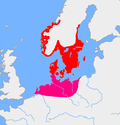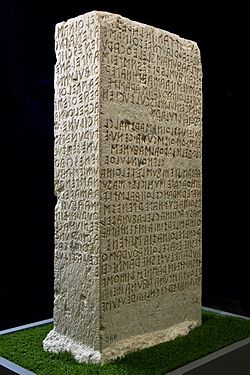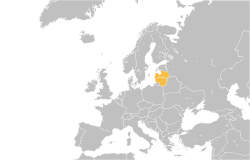Mysian was spoken by Mysians inhabiting Mysia in north-west Anatolia. Little is known about the Mysian language. Strabo noted that it was, "in a way,...
9 KB (745 words) - 01:34, 3 February 2025
Mysians /ˈmiːʒənz, ˈmɪʒənz/ (Latin: Mysi; Ancient Greek: Μυσοί, Mysoí) were the inhabitants of Mysia, a region in northwestern Asia Minor. Their first...
4 KB (378 words) - 07:06, 26 February 2025
The Indo-European languages are a language family native to the northern Indian subcontinent, most of Europe, and the Iranian plateau with additional native...
112 KB (10,365 words) - 17:14, 22 May 2025
of Mysian by a migration of the Moesi people; Strabo asserts that Moesi and Mysi were variants of the same name. Dacian was an Indo-European language (IE)...
145 KB (17,063 words) - 12:01, 24 March 2025
The Germanic languages are a branch of the Indo-European language family spoken natively by a population of about 515 million people mainly in Europe,...
95 KB (9,750 words) - 10:34, 11 May 2025
Indo-European languages. Far more work has gone into reconstructing PIE than any other proto-language, and it is the best understood of all proto-languages of its...
66 KB (6,000 words) - 21:58, 4 May 2025
the Paeonian language to the Mysian language, which was possibly a member of the Anatolian languages, or of the Armeno-Phrygian languages. Radoslav Katičić...
9 KB (795 words) - 20:29, 4 May 2025
The Slavic languages, also known as the Slavonic languages, are Indo-European languages spoken primarily by the Slavic peoples and their descendants. They...
77 KB (7,583 words) - 16:23, 4 May 2025
Mysia (category Articles containing Greek-language text)
across the Granicus (Biga Çayı) Aeolis Ancient regions of Anatolia Mysian language Mysians Telephus One or more of the preceding sentences incorporates text...
9 KB (990 words) - 06:17, 23 October 2024
The Indo-Aryan languages, or sometimes Indic languages, are a branch of the Indo-Iranian languages in the Indo-European language family. As of 2024, there...
77 KB (5,833 words) - 13:20, 19 May 2025
transcription delimiters. The Romance languages, also known as the Latin or Neo-Latin languages, are the languages that are directly descended from Vulgar...
173 KB (16,516 words) - 17:59, 10 May 2025
The Iranian languages, also called the Iranic languages, are a branch of the Indo-Iranian languages in the Indo-European language family that are spoken...
53 KB (4,066 words) - 21:48, 22 May 2025
Indo-European language and the only surviving representative of the Albanoid branch, which belongs to the Paleo-Balkan group. It is the native language of the...
187 KB (17,622 words) - 02:13, 22 May 2025
Common Germanic) is the reconstructed proto-language of the Germanic branch of the Indo-European languages. Proto-Germanic eventually developed from pre-Proto-Germanic...
131 KB (12,240 words) - 21:34, 18 May 2025
The Italic languages form a branch of the Indo-European language family, whose earliest known members were spoken on the Italian Peninsula in the first...
40 KB (4,267 words) - 22:02, 3 May 2025
Celtic languages (/ˈkɛltɪk/ KEL-tik) are a branch of the Indo-European language family, descended from the hypothetical Proto-Celtic language. The term...
71 KB (5,912 words) - 00:51, 8 May 2025
Paeonians (category Articles containing Ancient Greek (to 1453)-language text)
Paeonian language to the barely-attested Mysian language. Mysian was possibly a member of the Anatolian branch in the Indo-European language family or...
19 KB (2,247 words) - 16:50, 13 May 2025
Mochica language Puquina language Asia Hunnic language Indus Valley language Kaskean language Anatolia Hattic language Mysian language Korea Kara language Koguryo...
5 KB (543 words) - 05:28, 16 December 2024
an Indo-European language and the sole member of the independent branch of the Armenian language family. It is the native language of the Armenian people...
117 KB (8,458 words) - 01:18, 23 May 2025
Etruscan is modified Luwian. He accounts for the non-Luwian features as a Mysian influence: "deviations from Luwian [...] may plausibly be ascribed to the...
123 KB (12,401 words) - 10:25, 7 April 2025
('Daco-Thraco-Moesian complex') Thracian (?) Daco-Moesian Dacian, Moesian and Getic (?) Mysian (?) Paeonian Graeco-Phrygian Hellenic (?) Ancient Macedonian Greek Ancient...
36 KB (3,891 words) - 07:20, 18 May 2025
or Common Slavonic) is the unattested, reconstructed proto-language of all Slavic languages. It represents Slavic speech approximately from the 2nd millennium...
81 KB (7,647 words) - 22:43, 19 May 2025
304, 308, 310. Radulescu M. The Indo-European position of lllirian, Daco-Mysian and Thracian: a historic Methodological Approach. 1987. [page needed] Dras...
50 KB (4,987 words) - 03:51, 7 May 2025
Kuchean-Agnean languages, are an extinct branch of the Indo-European language family spoken by inhabitants of the Tarim Basin, the Tocharians. The languages are...
77 KB (7,459 words) - 16:17, 19 May 2025
language (/ɪˈlɪriən/) was an Indo-European language or group of languages spoken by the Illyrians in Southeast Europe during antiquity. The language is...
28 KB (3,177 words) - 17:59, 19 May 2025
also called Proto-Indo-Iranic or Proto-Aryan, is the reconstructed proto-language of the Indo-Iranian branch of Indo-European. Its speakers, the hypothetical...
38 KB (1,587 words) - 03:40, 18 May 2025
The Nuristani languages are one of the three groups within the Indo-Iranian language family, alongside the Indo-Aryan and Iranian languages. They have approximately...
23 KB (2,100 words) - 09:20, 8 May 2025
Origin of the Albanians (category CS1 Greek-language sources (el))
Albanian a language called "Daco-Mysian" by him, considering it a separate language from Thracian. Georgiev maintained that "Daco-Mysian tribes gradually...
185 KB (20,833 words) - 16:13, 13 May 2025
Alphabets of Anatolia (category Ancient Greek language stubs)
script, an alphabet of 21 letters used for the Phrygian language (22 for the Mysian language) which is very similar to early Greek epichoric alphabets...
4 KB (448 words) - 00:14, 17 February 2025
Albanoid (redirect from Albanoid language)
Indo-European (IE) languages, of which Albanian language varieties are the only surviving representatives. In current classifications of the IE language family,...
35 KB (3,489 words) - 02:21, 28 April 2025



















